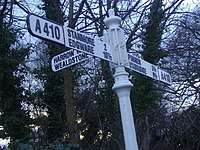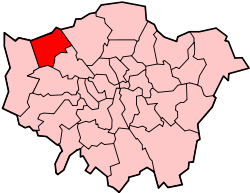Harrow Weald
Harrow Weald is the northernmost part of the town of Harrow in Greater London, England. It is formed from a leafy 1930s suburban development along with ancient woodland, and forms part of the London Borough of Harrow.
| Harrow Weald | |
|---|---|
_-_geograph.org.uk_-_578.jpg) Grim's Dyke and Grimstone Lake | |
 Harrow Weald Location within Greater London | |
| Population | 11,376 (2011 Census. Ward)[1] |
| OS grid reference | TQ151907 |
| London borough | |
| Ceremonial county | Greater London |
| Region | |
| Country | England |
| Sovereign state | United Kingdom |
| Post town | HARROW |
| Postcode district | HA3 |
| Dialling code | 020 |
| Police | Metropolitan |
| Fire | London |
| Ambulance | London |
| London Assembly | |
Locale, geography and history
.jpg)


The word Weald is Old English in origin, meaning woodland. It was recorded as waldis in 1303 and welde in 1382, but the name Harrow Weald is not recorded until 1553. It was then part of the great Forest of Middlesex.[2]
Harrow Weald is near Bushey Heath, Stanmore, Wealdstone, Headstone and Hatch End. It is in the HA postcode area.
The south of the area is a suburban development with houses, schools, small shops, supermarkets and pubs (notably Bombay Central, formerly the Weald Stone Inn, and before that the Red Lion). The area expanded around the First World War[3] and continued to grow quickly: the population grew from 1,517 in 1901 to 10,923 in 1931.[4]
The Harrow Weald campus of Harrow College (previously a grammar school, then a 16+ college) and Harrow Weald Cemetery are at the northern edge of the built up area. All Saints churchyard and its extension adjoin this cemetery and their most famous interment is of Leefe Robinson, a pilot who was awarded the Victoria Cross.
Ancient woodland on high ground fills most of the northern part of Harrow Weald on the border of Greater London (and the traditional county of Middlesex) with Hertfordshire. The area is one of the highest in Greater London; the highest point in Middlesex is near the woods at 502 feet (153 m). The eastern part of the woods merges into those of Stanmore and encompasses Bentley Priory. The priory's grounds are now Bentley Priory Nature Reserve, a biological Site of Special Scientific Interest. Along the southern edge of the high ground runs the road Old Redding and a car park here gives views over parts of London. The western part of the woodland forms Harrow Weald Common, which adjoins Harrow Weald SSSI, a geological Site of Special Scientific Interest. Other smaller woods surround the Grim's Dyke Hotel, the former country house of W. S. Gilbert.[5] Gilbert and Sullivan's comic operas are frequently performed here. The house is named after the nearby earthwork Grim's Ditch, a 3-mile long ancient monument that runs from Harrow Weald to Pinner Green. The monument remains largely mysterious but is known to have been named in the Saxon era.[6] The ditch hints at a long history of habitation in the area and many artefacts have been found on the common to support this.
The Friends Of Harrow Weald is based at Harrow Weald Recreation Ground.[7]
Demography
The 2011 census showed that in the Harrow Weald ward, 53% of the population was white (41% British, 6% Other, 5% Irish). The largest non-white group was Indian at 19%. Of the 4,160 household tenures, 68.4% of them are owned, 15.9% are socially rented and 13.7% are privately rented. The unemployment rate of economically active people was 4.9%. The median age of the population is 39.[8]
Transport
There are no train stations in the centre of Harrow Weald, but Headstone Lane railway station is to the west, whereas Harrow & Wealdstone station is to the south.
Buses
London Bus routes 140, 182, 186, 258, 340, 640, H12, H18, H19 and N18 operate through the area.[9] [10] [11] The N140 bus also goes through Harrow Weald, it was introduced on the 17th June 1972.
Local councillors
As of May 2018, the local councillors for Harrow Weald are:
Councillor Ramji Chauhan, Councillor Stephen Greek and Councillor Pritesh Patel
References
- "Harrow Ward population 2011". Neighbourhood Statistics. Office for National Statistics. Retrieved 24 October 2016.
- "London Borough of Harrow, Management Plan: Old Redding Complex, p. 2, 2010". Archived from the original on 14 September 2012.
- "Harrow, including Pinner : Suburban development - British History Online". www.british-history.ac.uk.
- "Harrow Weald CP through time - Census tables with data for the Parish-level Unit". www.visionofbritain.org.uk.
- "Country House Hotel Harrow & Wedding Venue - The Grim's Dyke Hotel". www.grimsdyke.com.
- Grim's Ditch
- [cite web|url=https://www.Harrowweald.co.uk%7Ctitle=Central Park Of Harrow Weald - Harrow Weald Recreation Ground|website=https://www.Harrowweald.co.uk]
- Services, Good Stuff IT. "Harrow Weald - UK Census Data 2011". UK Census Data.
- Matters, Transport for London - Every Journey. "Keeping London moving" (PDF). Transport for London.
- "Bus Routes Passing Harrow Weald (Metroline) Bus Garage". www.notrog.plus.com. Retrieved 14 March 2020.
- Cantillon, Estelle; Pesendorfer, Martin (9 December 2005), "Auctioning Bus Routes: The London Experience", Combinatorial Auctions, The MIT Press, pp. 573–592, ISBN 978-0-262-03342-8, retrieved 14 March 2020
